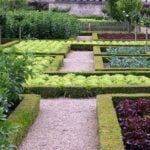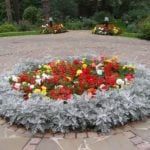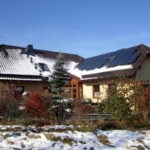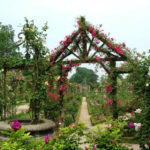European ash is a close relative of evergreen olive. Since ancient times, ash is affectionately called clear, bright. Ash groves are always saturated with the sun, because through their delicate leaves perfectly penetrate the sun’s rays to the tree more light and heat got. It is designed for every leaf, coming in motion from the slightest breeze.
European ash is a heat-loving deciduous tree. It has more than 50 varieties, among which there are low trees, and luxurious 40-meter beauties. For example, highly decorative ash, which is used in the art of bonsai, is not higher than 1.5 m. white Ash grows up to 12 m, and the most famous member of the genus-ordinary ash – under favorable conditions is able to grow up to 30 m.
Features of european ash
European ash is light-loving and delicate thanks to its arcuate branches, elongated spreading crown and transparent foliage, where the leaves are located at a short distance from each other. Grows quickly, and blooms in April-may before the leaves appear.

On one tree peacefully coexist male and female flowers. But what is surprising: male and female flowers from the same tree are not capable of pollination — when women are ready to take pollen, men are not yet ripe. In addition, the flowers of ash have no corollas, and they are unattractive to buzzing pollinators. Therefore, always plant a few ash trees side by side for cross-pollination. The only exception is the fraxinus ornus – it is well pollinated by insects, as its flowers have a whisk.
The root system of ash depends on the growing conditions. Usually it has no taproot and lies close to the surface. But if the ash is experiencing a shortage of moisture, then it develops a tap root with a mass of horizontal processes, which reaches the level of groundwater. Therefore, if the groundwater under the ash lies up to 1.5 m, it is not threatened with death from drought. And some ash giants get to water through thickness of the earth in 3 and more meters.
Landing european ash
Ash prefers sunny places and drained fertile soils, so take care of organic matter with the addition of calcium . Light wood does not tolerate waterlogging and salinization of the soil, which should be either neutral or close to that. Acidic and alkaline soils are unacceptable for ash.
Ash is very hardy and perfectly propagated by seeds. Around the tree every year formed young shoots, which can be easily planted in other places. Ash seeds are oblong lanceolate lionfish, rounded on one side. They ripen in late September-early October. And look here is so:

But to grow a whole tree of seeds for a long time and troublesome. So let’s consider planting ash seedlings.
Planting of european ash seedlings
Prepare the planting hole size for 1/3 more the size of the clod of earth on the roots of the seedling. At the bottom of the pits be sure to pour the drainage layer: crushed stone, small pebbles or coarse sand about 1/4 height. When planting ash, a lump of soil with roots should be 10-15 cm above the soil level. Over time, the earth will settle, and the root neck of the tree just stand on the same level with the soil.
Before placing the seedling in the hole, carefully pour it with water. In advance, fix around the support hole, align the seedling strictly vertically, attach it to the supports as shown in the photo, and only then fill the hole with a pre-prepared soil mixture, slightly compacting it.
The ideal soil mixture for ash: leaf soil, humus and sand in the ratio-1:2: 1. After planting, mulch the tree circles with peat, sawdust or wood chips. The distance between the trees take at least 5 m, but if you bought seedlings of dwarf varieties of the ash, and planted them at such a distance from each other to Mature plants do not shade each other.
Subsequently, you will be able to reproduce the ash grown from purchased seedlings, cuttings or cuttings. Ash, as a rule, has an anchor root system, lying horizontally. From the main roots are formed vertical processes, from which there is a young shoots. So, having ash in the country, you are always provided with their own planting material. Maybe you will raise that as handsome as in this photo.
Care for european ash
On fertile soil, your seedlings will quickly go into growth and in a year will add 30-40 cm in height. And caring for them is not particularly problematic.
- Fast-growing young branches can be periodically pruned, forming the crown of the tree and giving it the desired shape. Pruning is done in the spring before the flowering of the tree. But not get carried away! – ash does not tolerate pruning, but it is necessary to free it from dry and broken branches.
- Fertilize your ash in the spring with nitrogen-containing fertilizers: manure-2 kg, urea-15 g, calcium and ammonium nitrate-25 g per 20 liters of water.
- Mulch for the winter need only young plants in the first 2-3 years after planting. And adults, receiving the force of the ash trees in mulch for the winter not needed (unless the winter forecasts are not going to be very cold). Some types of adult ash trees can withstand temperatures down to -40 C.
- Watering ash is required in dry periods and after planting (4-5 days in a row). It tolerates a short drought perfectly.
Types of ash
Fraxinus ornus
Fraxinus ornus is often called floral, because at the time of flowering it is strewn with a fragrant cover of white inflorescences. Does not grow above 12 m, has a rounded crown, a remarkable svetloba and excellent drought tolerance. Not hardy and suitable for planting only in the southern regions.

Fraxinus excelsior
Fraxinus excelsior has many forms, each of which is decorative in its own way. Its height reaches 30 m. it Grows quickly, light-loving, frost-resistant. . It is more demanding on soils than other types of ash. Long-lived, in one place can grow for about 300 years.

Fraxinus pubescens
Fraxinus pubescens is the most frost-resistant type of ash, up to 20 m high, with a spreading openwork crown. It tolerates temporary flooding and slight salinization of the soil.


















